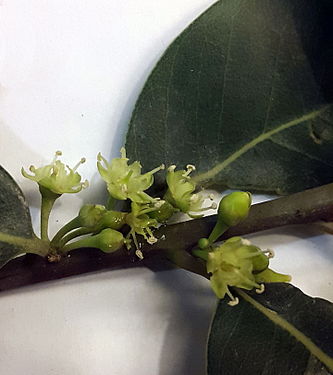|
Sideroxylon inerme
Sideroxylon inerme (aMasethole or white milkwood, Afrikaans: wit-melkhout, Xhosa: Ximafana, Zulu: Umakhwelafingqane)[2] is a southern and eastern African coastal tree, with dense foliage, black berries and small, foetid, greenish flowers. The tree's generic name means "Iron-wood" in Greek, referring to its very hard timber. It is one of South Africa's "Protected Trees" and several specimens are provincial heritage sites.[3] This is the only member of the genus Sideroxylon in Southern Africa. Distribution Sideroxylon inerme trees are scattered through the coastal woodlands and littoral forests of southern and eastern Africa, from the Cape Provinces of South Africa in the south to Somalia in the north, and on Aldabra, the Comoro Islands, and the Mozambique Channel Islands in the western Indian Ocean.[1] Historically, dense forests of large milkwood trees used to exist along the coast and bays of Cape Town, especially at Noordhoek, Macassar and Gordons Bay. The milkwood is not endangered but it is one of South Africa's Protected Trees, which means that it is illegal to damage, move or destroy them.[3] DescriptionSideroxylon inerme is a semi-coastal sturdy broadleaf evergreen tree with dense foliage, displays of white bisexual flowers and edible purplish-black berries. It boasts leathery, spiral leaves, which, like the berries, contain milky latex. Young branches and new leaves are always covered with fine hairs. The tree can reach 15 m.[citation needed] The milkwood has considerable value in traditional medicine and attracts birds, monkeys and other animals to its flowers and fruits : Speckled mousebirds eat the flowers ; birds, bats, monkeys and bush pigs eat the fruit. It is also an effective firebreak and is cultivated for that purpose.[3] SubspeciesSideroxylon inerme includes three subspecies:[1]
Historical aspects The white milkwood has great significance in South Africa's heritage, with three specimens proclaimed as provincial heritage sites:
GalleryWikimedia Commons has media related to Sideroxylon inerme.
See alsoReferences
Information related to Sideroxylon inerme |
||||||||||||||||||||||||||||||||




